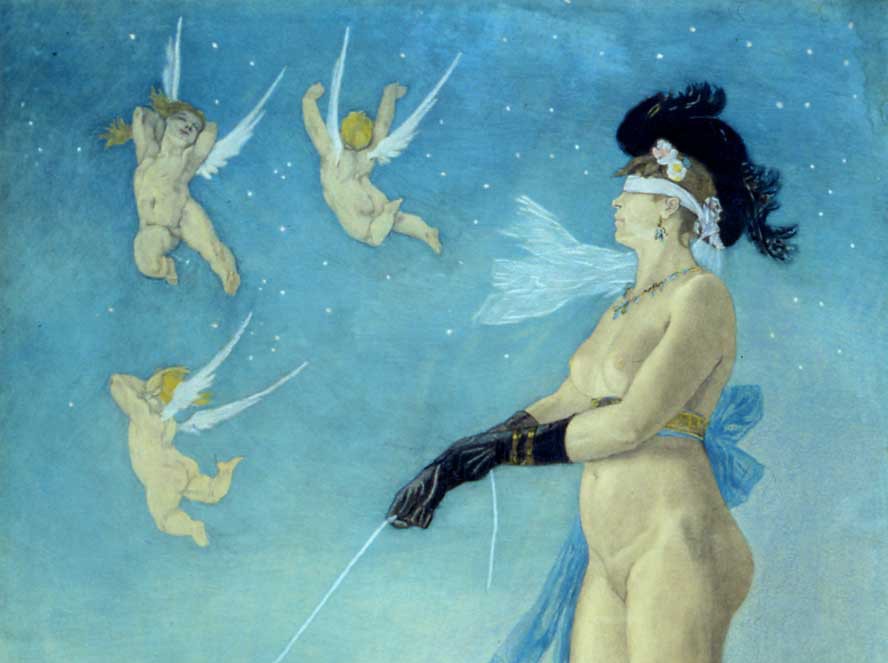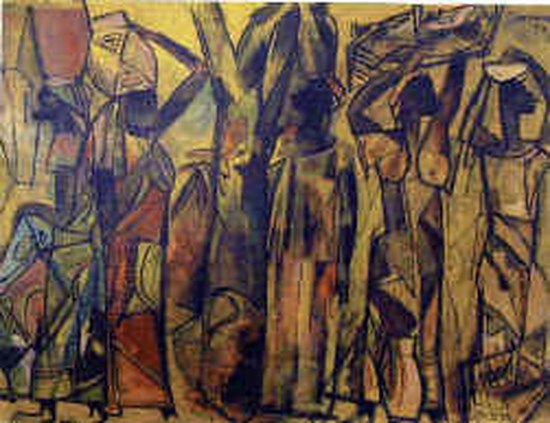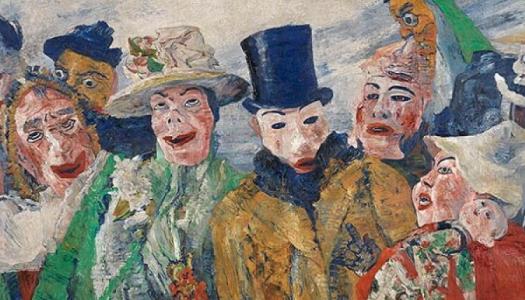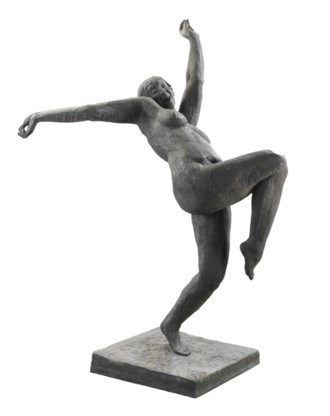This blog focuses on the 15 largest Flemish artists in the period 1820-1950, arranged according to their position within Artprice. In other words, what do they yield and how marketable are their works.
15. Fauvist Rik Wouters
Hendrik Emil (Rik) Wouters (1882 – 1916) was a Belgian sculptor, painter, draftsman and etcher. He is considered part of the Fauvism movement. Wouters wanted to capture the light without falling into pointillistic dots. His work is determined by composition, harmony and contrast. In his areas of color he quickly tends towards the abstract. Three quarters of Wouters' oeuvre is an ode to his own younger wife and muse.
In August 1914, the war drama broke out and he was deployed as a soldier in the defense around the city of Liège. He was later interned in Camp Zeist and later settled in Amsterdam. Despite his deteriorating health and a lot of pain, he made a series of canvases. That year he exhibited a series of works on paper in the Print Room of the Rijksmuseum in Amsterdam. His major retrospective in the Stedelijk Museum followed in 1916, but it was already too much for him; he had to quickly return home in a taxi. The cancer had eaten at him. His wife Nel has managed his estate with verve.
Carzy Violence
14. Neo realist Gustave van de Woestijne
Gustave Van de Woestyne (1881 –1947) was a Belgian painter in a symbolist, neorealist, expressionist and surrealist style. Van de Woestyne was an introverted and religiously inspired artist. The influence of the Pre-Raphaelites can be found in his early, symbolic work. We see this influence of the old masters especially in his numerous portraits. Together with George Minne Valerius De Saedeleer and Albijn Van den Abeele, he formed the so-called first group of Sint-Martens-Latem, also called the Latem school.
He was noticed early on and was able to participate in international exhibitions in Amsterdam, The Hague and Venice. He traveled through Europe and only settled in Mechelen in 1925, where he was appointed director of the Academy of Fine Arts.
Together with Gustave De Smet and Frits Van den Berghe, among others, he was part of the Les 9 art circle. Ten years later, he became a member of the Les Compagnons de l'Art circle with them. From 1928 he received help and support from the Brussels couple David and Alice van Buuren. He did a large amount of work for them. The largest public collection of Gustaves work can be seen in the Museum van Buuren in Uccle.

13. Félicien Rops: decadent painter
Another famous Belgian artist is Félicien Rops (Namur 1833 - 1898). He was a Belgian graphic artist, painter and caricaturist. His decadent style was praised by Baudelaire, Manet, Gautier and Mallarmé. His work is often satanistic and slightly pornographic. The female figures, who personify temptation and evil, are often modeled on the Flemish girls that Rops was so fond of. He made satirical prints early on, against the hypocrisy of the church. He cherished his obscurity and should have nothing to do with his hero status on this list.

12. Symbolist Fernand Khnopff
Khnopff (Grembergen 1858 – 1921 Brussels) was a painter, sculptor and designer. Khnopff's most famous subjects are landscapes in Fosset and portraits of ladies from the Brussels bourgeoisie. He was also active with cityscapes of Bruges and symbolist compositions. Most of the paintings convey a mysterious, alienating atmosphere. His characters often exhibit androgynous features. His masterpiece is The Caress from 1896, a depiction of Oedipus snuggling against the sphinx.

Museum van Schone Kunsten, De liefkozing
11. Im- en Expressionist Leon de Smet
Léon De Smet (1881–1966) was a Flemish painter and brother of Gustave De Smet. Together they belong to the second group of Sint-Martens-Latem. Léon was friends there with, among others, the artists Valerius De Saedeleer, Maurice Sys, Constant Permeke, Frits van den Berghe and Gustave Van de Woestyne.
At the outbreak of the First World War, Léon fled to London, where he had his own exhibition in the Leicester Gallery in 1917. A major exhibition followed in 1920 in the Brussels Galerie Georges Giroux. In 1953 he was honored at the Ghent Museum of Fine Arts with an individual exhibition; Many of his works still hang there. Léon De Smet's oeuvre is classified as impressionism, expressionism and pointillism. He mainly painted with keys in a muted color palette.
10. Impressionist & Luminist Emile Claus
Emile Claus (1849 – 1924) was of humble origins, trained at the Antwerp Academy and was influenced by Impressionism in Paris. After this he developed, with his landscapes and flower gardens shimmering with sunlight, into the most important Belgian luminist with elements of realism and impressionism. In 1904, Claus founded the art circle 'Vie et Lumière' in Brussels. In his works, atmosphere and light are the main sources of inspiration. 
Bron foto: Wiki Commons
9. Expressionist Constant Permeke
Permeke (Antwerp 1886 – Ostend 1952) is an expressionist painter and sculptor. His father was a landscape painter and taught him the first tricks. His children Paul and John are also painters. Constant Permeke is best known for his strong and solemn depictions of sailors and fishermen with their wives. He also painted farmers, landscapes and interiors. He emphasized man's hard work and his connection with the earth. His figures are deliberately distorted and his colors are warm. His figure compositions reveal his preference for the geometric and the influence of Cubism and Léger. In his sculptures he preferred the human figure, which he depicted very expressively, such as this Niobe that can be admired in the Kroller Muller.
Constant Permeke was a central figure of the avant-garde movements Selection, L'Art Vivant and Kunst van Heden and later director of the National Higher Institute for Fine Arts in Antwerp. The Permeke Museum is, together with the Ensor House, a satellite museum of the Mu.ZEE in Ostend.

8. Cubist Gustave De Smet
De Smet was born as the son of the house painter-decorator and photographer Jules De Smet. Gustave had a brother four years younger, the impressionist painter Léon De Smet. Both attended the Ghent Academy, where his education was irregular. De Smet married Gusta Van Hoorebeke in 1898 and continued to live in Ghent. It was not until 1908 that he followed his brother Léon to Sint-Martens-Latem. There their attention was mainly focused on the impressionistic luminism of Emile Claus, among others. During the First World War, Gustave emigrated to the Netherlands with his family and his friend Frits Van den Berghe and was influenced by Dutch expressionism and the Frenchman Henri Le Fauconnier. In 1922 he returned to Belgium to live with Permeke in Ostend together with Frits Van den Berghe. At that time he had already initiated the Sélection movement, with the Brussels art experts André de Ridder and Paul-Gustave van Hecke. After a few months he returned to his Lys region and finally settled in Deurle in 1927, where a museum is still located in his former home.

7. Theo van Rijsselberghe
Théo van Rysselberghe (1862-1926) is the Belgian neo-impressionist who was born into a French-speaking Ghent bourgeois family, attended the Ghent Academy of Fine Arts and the Brussels Academy of Fine Arts under the leadership of Jean-François Portaels. This painter, who had spent many months in Morocco, had a great impact with his North African paintings on the young Van Rysselberghe, where he traveled when he was 20. Along the way he visited the Prado Museum, where he particularly admired the "old Flemish, Italian and Spanish masters" and in Seville he met Constantin Meunier, who was making a copy of Pedro de Campaña's "Descent from the Cross". He would stay in Morocco for four months. He drew and painted the picturesque scenes on the street and returned to Belgium with about 30 works. With these works he participated in the "Cercle Artistique et Littéraire" in Ghent and later in 1883 in the Salon L'Essor in Brussels before an enthusiastic audience. Van Rysselberghe left for Haarlem in September 1883 to make a copy of a work by Frans Hals. The light in this work and its accurate representation in his own paintings would captivate him for the rest of his life.
Théo van Rysselberghe is a painter of the sun and depicts color and is considered an important leader of pointillism, with which he inspired Dutch artists such as Jan Toorop. During his third trip to Morocco in 1888, he literally and figuratively saw the light and started applying dots of unmixed paint with which he managed to express light and color in a sublime way. He will continue to use this technique throughout his career. He often made society portraits, sun-drenched landscapes (from Flanders to Morocco), seascapes and the female nude. His oeuvre is an ode to the beauty of life and to painting itself. He played an important role in the European art world. For example, he was one of the founders of the avant-garde group Les Vingt in 1883.

6. Avant Gardist Floris Jespers
Jespers was born into an Antwerp artist family. His father Emile Jespers was a sculptor. Together with his older brother Oscar, he attended the Academy at an early age. Oscar became a sculptor and Floris a painter.
Until 1917, his work was very similar to that of Rik Wouters, both in terms of color palette and theme. Afterwards, Cubist elements made their appearance and in the early 1920s he also started using constructivist concepts and occasionally painted abstract works. But the figurative remains dominant. His most important works were created in the 1920s, with highlights such as Adam and Eve (1924), The Chess Game (1926), Bonjour Ostende (1927) and Salut, Messieurs! (1927).
After the First World War, Antwerp was one of the most important centers of the avant-garde in Belgium, with the poet Paul van Ostay and the Jespers brothers as leading figures. Other modernist artists were Jozef Peeters and Jos Leonard, the poets Wies Moens and Jan Burssens, the art critic Michel Seuphor and the architect Huib Hoste. They organized exhibitions and conferences on avant-garde art.
From 1924 onwards, Jespers regularly came to Knokke at 'De Beir', who bought many of his works until the end of the 1920s when expressionism won over modernism and Jesper's early works were less en vogue.
Jespers also evolved with powerful paintings towards expressionism and on the other hand towards a refined art-deco style.

5. Symbolist Leon Spilliaert
In retrospect, Léon Spilliaert (1881 –1946) is one of the most important Belgian painters of the first half of the twentieth century and the founder of literary symbolism. Especially for 1914, he was the eccentric gloomy seer of a strange reality. He drew and painted spontaneous work, strongly influenced by a idiosyncratic self-image and his introverted, melancholic disposition.
After an unsuccessful education at the Art Academy in Bruges as a student of Pieter Raoux, he visited the World Exhibition in Paris with his father in 1900. He discovered European contemporary art in the works of art by Jan Toorop, Giovanni Segantini, Ferdinand Hodler and Gustav Klimt. He read widely and admired Friedrich Nietzsche, Ovid, Eugene Delacroix and Edgar Allan Poe. Spilliaert initially used a lot of Indian ink and had a deep, visionary and smooth drawing style from the start.
In 1907 there was a group exhibition in Ostend, organized by Le Center d'Art, with paintings by Van Gogh and Odilon Redon. Introduced by Verhaeren, Spilliaert was also able to participate. Redon in particular must have made an impression on Spilliaert with his dream world with numerous light-dark effects and silhouettes. His approximately twenty self-portraits are the most striking. He depicts himself at chest level, in front or side view, as a civilian man in a conventional dark suit with a stiff white shirt collar. He looks at us with a horrible look, with hollow or black-rimmed eyes, in a play of light and shadow, with a force that leaves a deep, oppressive impression.
4. Post Expressionist Roger Raveel
Roger Henri Kamiel Raveel (1921 –2013) was a Flemish post-expressionist painter and maker of ceramics and art objects. His work is reminiscent of pop art. Raveel received his first academic training from Hubert Malfait and later at the Royal Academy of Fine Arts of Ghent.
In 1948 he founded the group La Relève with Jan Burssens, Kamiel D'Havé and Pierre Vlerick. He felt like he had to rethink everything and see things in a different light with data from physics and new technical developments. In the period 1955-1961 Raveel worked mainly abstractly. In the 1960s he emerged as a pacesetter of the new figuration together with Raoul De Keyser, Etienne Elias and the Dutchman Reinier Lucassen. The abstraction of Piet Mondriaan and the expressionism of Vincent van Gogh were sources of inspiration in the creation of the painting style that also became known as the 'new vision'.
Raveel's style is characterized by the mixture of abstract and figurative painting. For example, in the image of a typical Flemish rural backyard with washing wire and concrete walls, a completely white square appears (almost the hallmark of a Raveel). Those white areas actually represent voids. Raveel also made three-dimensional objects on several occasions. And he also worked as a graphic artist. In 1984, for example, 33 prints of his Genesis were published, accompanied by 33 matching poems by Hugo Claus. Since 1999 he has had his own museum in his native village of Machelen-aan-de-Leie.
3. Paul Delvaux: poetic realism
Paul Delvaux (Antheit 1897 – Veurne 1994), was often classified as Belgian surrealism. He found this interpretation of his work too narrow, too formalistic and above all too superficial. He simply wanted to create "a poetic realism". He was strongly influenced by the metaphysical painting of De Chirico and succeeds in creating a dreamy and hypnotic atmosphere in his work, with female nudes in the leading role. Delvaux is known for its characteristic and mysterious imagery. In this he unites elements from expressionism, symbolism and surrealism.
2. James Ensor: painter of the symbolism
James Sidney Edouard Baron Ensor (Ostend 1860-1949) is without a doubt one of the most remarkable artists of the 19th century. A Belgian painter of symbolism. He is generally recognized as the most important innovator of modern art in Belgium. He is a true individualist who was not easily categorized into one art direction or another. Ensor is known for his versatile and sensitive use of color and free way of painting. Rubens and Bosch both inspired him. Ensor had an avant-garde and modern view with a sharp criticism of the bourgeoisie. Ensor's paintings are full of extremes. Initially he made true-to-life realistic representations of interior scenes and beach views. Later the great transition to his fantasy world takes place. His work often features macabre shapes with skeletons, masks and demons. He reveals the ridiculousness of humanity through his imagination. The monumental painting The Entry of Christ into Brussels (1888) perfectly captures the spirit of his work. A visit to the Ensor House in Ostend is highly recommended.

1. René Magritte: the biggest surrealist
René Magritte (Lessons 1898 - 1967) is the leader of the Belgian Surrealists and the best-known Belgian artist in the world. And because surrealism is one of the important art movements of the 20th century, he has had a lot of influence. In the aftermath of the First World War, many artists sought refuge in other dimensions such as the dream world, fantasy or the unconscious. However, Magritte paints everyday realities and therefore the absurdity of human existence. “Reality is an illusion.” The Magritte Museum in Brussels has the largest collection of Magritte's works: more than 230 items. Nude women and faithfully painted fish appear in many of his works. This is probably a reference to his mother, who Magritte found in the Sambre River after she had committed suicide. Magritte's work, like Salvador Dali and Carel Willink, is very finely painted. This emphasizes the realistic effect of the non-existent representations. Magritte's best-known work is without a doubt La Trahison des Images (1928-29) or 'The Betrayal of the Presentation'. An idea has its origins in the mind. So it's not a pipe. Or this one: Reproduction interdite:

